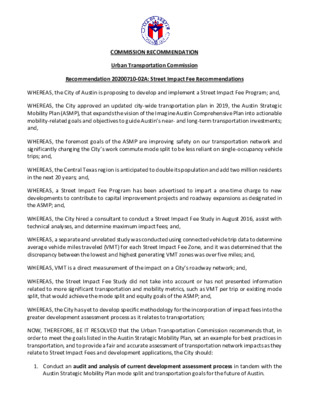20200710-02A: Street Impact Fee Recommendations — original pdf
Recommendation

COMMISSION RECOMMENDATION Urban Transportation Commission Recommendation 20200710-02A: Street Impact Fee Recommendations WHEREAS, the City of Austin is proposing to develop and implement a Street Impact Fee Program; and, WHEREAS, the City approved an updated city-wide transportation plan in 2019, the Austin Strategic Mobility Plan (ASMP), that expands the vision of the Imagine Austin Comprehensive Plan into actionable mobility-related goals and objectives to guide Austin’s near- and long-term transportation investments; and, WHEREAS, the foremost goals of the ASMP are improving safety on our transportation network and significantly changing the City’s work commute mode split to be less reliant on single-occupancy vehicle trips; and, WHEREAS, the Central Texas region is anticipated to double its population and add two million residents in the next 20 years; and, WHEREAS, a Street Impact Fee Program has been advertised to impart a one-time charge to new developments to contribute to capital improvement projects and roadway expansions as designated in the ASMP; and, WHEREAS, the City hired a consultant to conduct a Street Impact Fee Study in August 2016, assist with technical analyses, and determine maximum impact fees; and, WHEREAS, a separate and unrelated study was conducted using connected vehicle trip data to determine average vehicle miles traveled (VMT) for each Street Impact Fee Zone, and it was determined that the discrepancy between the lowest and highest generating VMT zones was over five miles; and, WHEREAS, VMT is a direct measurement of the impact on a City’s roadway network; and, WHEREAS, the Street Impact Fee Study did not take into account or has not presented information related to more significant transportation and mobility metrics, such as VMT per trip or existing mode split, that would achieve the mode split and equity goals of the ASMP; and, WHEREAS, the City has yet to develop specific methodology for the incorporation of impact fees into the greater development assessment process as it relates to transportation; NOW, THEREFORE, BE IT RESOLVED that the Urban Transportation Commission recommends that, in order to meet the goals listed in the Austin Strategic Mobility Plan, set an example for best practices in transportation, and to provide a fair and accurate assessment of transportation network impacts as they relate to Street Impact Fees and development applications, the City should: 1. Conduct an audit and analysis of current development assessment process in tandem with the Austin Strategic Mobility Plan mode split and transportation goals for the future of Austin. a. Determine if current measures encourage desired outcomes for the City’s transportation network and growth. b. Consider revising development assessment process, including Transportation Impact Analysis process and methodology, to reflect priorities of the City (focus TIA recommendations on Transportation Demand Management and funding alternative modes to single occupancy vehicles, elimination of Level of Service (LOS) as a measurement of roadway capacity failure with a replacement of Vehicle Miles Traveled (VMT)). c. Current discussion has only been about the addition of a Street Impact Fee, not about modification to the greater transportation policy and development assessment process. As presented, the policy provides “more predictability” by raising the floor of costs, not by also providing a clear and predictable ceiling or how this impact fee would change existing development assessment procedures. A complete policy with respect to transportation for development applications should be understood before the item is considered for approval by City Council. 2. Modify maximum street impact fees for all zones to be proportionate to the average VMT per vehicle trip originating or ending in the zone, or additional data collection and research as necessary. a. Ensure that zones that generate the most vehicle miles per person trip are charged proportionally to the impact imposed on the roadway network. This will incentivize development in low VMT- generating zones and/or zones that are able to accommodate proportionally more multimodal travel. b. Ensure that minimum and maximum fee reductions are calculated in an administrative manner. c. Emphasize the impact that parking has on vehicle trips to a project and incentivize the reduction of parking in future development. 3. Develop predictable and straightforward system such that developers will easily be able to determine the maximum amount their project is responsible for in advance. a. Consider creation of an online map with maximum impact fees per zone clearly listed. b. For formally going through the development assessment process, consider the creation of a Street Impact Fee Worksheet to be submitted with the TIA Determination Worksheet. 4. Create an online portal or status check to hold developers accountable for paying and to keep track of costs and expenditures for each zone. a. Allow developers to check the status of their application. b. Internal City of Austin page viewer to be used for keeping track of developments in each zone, projects that have been/are currently being funded, what percentage of funding is still needed, who has yet to pay Street Impact Fee, etc. 5. Consider methodology of trip generation, existing mode split consideration, and VMT per person-trip vs per vehicle-trip for new developments. a. First, determine the zone in which the project will be constructed in and the given land use. b. Calculate estimated vehicle trips using the Institute of Transportation Engineers (ITE) Trip Generation Manual. Use average number of person trips per vehicle trips for land use to determine entire expected entering and exiting trips from the site. c. Utilize American Community Survey (ACS) Census Data to determine existing mode split in project area. Apply to person trip generation to estimate the number of trips for each mode. d. Use (Average VMT Per Vehicle Trip Per Zone) x (Estimated Number of Vehicle Trips) = Total Estimated Daily VMT Impact on Roadway Network. Date of Approval: July 10, 2020 Record of the vote: 8-0 with Commissioners Leyton, Weatherby and Wilfley absent Attest: Emily Smith, staff liaison